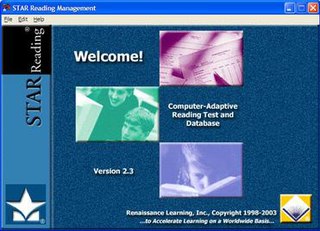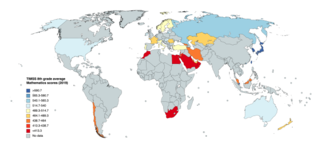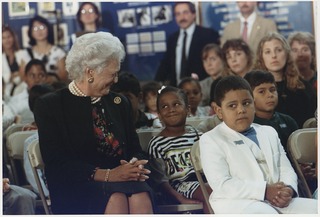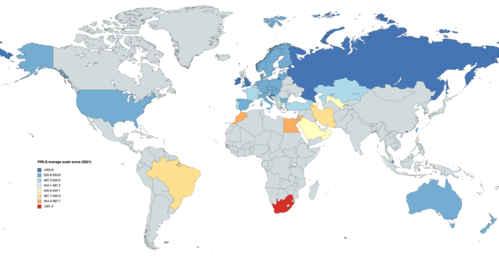
Phonics is a method for teaching people how to read and write an alphabetic language. It is done by demonstrating the relationship between the sounds of the spoken language (phonemes), and the letters or groups of letters (graphemes) or syllables of the written language. In English, this is also known as the alphabetic principle or the alphabetic code.

A standardized test is a test that is administered and scored in a consistent, or "standard", manner. Standardized tests are designed in such a way that the questions and interpretations are consistent and are administered and scored in a predetermined, standard manner.

The Programme for International Student Assessment (PISA) is a worldwide study by the Organisation for Economic Co-operation and Development (OECD) in member and non-member nations intended to evaluate educational systems by measuring 15-year-old school pupils' scholastic performance on mathematics, science, and reading. It was first performed in 2000 and then repeated every three years. Its aim is to provide comparable data with a view to enabling countries to improve their education policies and outcomes. It measures problem solving and cognition.
DIBELS is a series of short tests that assess K-8 literacy.

Synthetic phonics, also known as blended phonics or inductive phonics, is a method of teaching English reading which first teaches the letter sounds and then builds up to blending these sounds together to achieve full pronunciation of whole words.
The Education Quality and Accountability Office (EQAO) is a Crown agency of the Government of Ontario in Canada. It was legislated into creation in 1996 in response to recommendations made by the Royal Commission on Learning in February 1995.
The New England Common Assessment Program was a series of reading, writing, mathematics and science achievement tests, administered annually, which were developed in response to the Federal No Child Left Behind Act. Starting in 2005, school students in New Hampshire, Rhode Island, and Vermont participated in NECAP, and Maine joined the assessment program in 2009. It was a collaborative project of the New Hampshire, Rhode Island and Vermont departments of education, with assistance from the National Center for the Improvement of Educational Assessments. Measured Progress, an assessment contractor from Dover, New Hampshire, coordinates production, administration, scoring and reporting.

The National Assessment of Educational Progress (NAEP) is the largest continuing and nationally representative assessment of what U.S. students know and can do in various subjects. NAEP is a congressionally mandated project administered by the National Center for Education Statistics (NCES), within the Institute of Education Sciences (IES) of the U.S. Department of Education. The first national administration of NAEP occurred in 1969. The National Assessment Governing Board (NAGB) is an independent, bipartisan board that sets policy for NAEP and is responsible for developing the framework and test specifications.The National Assessment Governing Board, whose members are appointed by the U.S. Secretary of Education, includes governors, state legislators, local and state school officials, educators, business representatives, and members of the general public. Congress created the 26-member Governing Board in 1988.
The Iowa Assessments also known informally as the Iowa Tests, formerly known as the ITBS tests or the Iowa Basics, are standardized tests provided as a service to schools by the College of Education of the University of Iowa. Developers Everett Franklin Lindquist, Harry Greene, Ernest Horn, Maude McBroom, and Herbert Spitzer first designed and administered the tests in 1935 as a tool for improving student instruction. The tests are administered to students in kindergarten through eighth grade as part of the Iowa Statewide Testing Programs, a division of the Iowa Testing Programs (ITP). Over decades, participation expanded and currently nearly all school districts in Iowa participate annually in the program, as do many other school districts across the United States. In a cooperative relationship, participating schools receive ITBS test materials, scoring and reporting services and consultation in the use of ITBS for instructional purposes, and ITP utilizes participation by schools in research and test development. Both the ITBS and Iowa Tests of Educational Development (ITED) were revised in the 2011–2012 school year. They were rebranded the Iowa Assessments. In 2016–2017, Iowa Assessments will roll out their new testing program, Next Generation Iowa Assessments.
Accelerated Reader is a website used to assist students with reading skills. It is a digital program that helps students and teachers manage and monitor independent reading practice in both English and Spanish. Students pick a book at their own level and read it at their own pace. When students finish the book, they take a short quiz on the computer to check their understanding. As students read and take quizzes, they earn amount of points depending how thick the book is; the more thin the book is, the less words it gives them. It also tracks the students' progress toward their individualized Accelerated Reader goals.

STAR Reading, STAR Early Literacy and STAR Math are standardized, computer-adaptive assessments created by Renaissance Learning, Inc., for use in K–12 education. Each is a "Tier 2" assessment of a skill that can be used any number of times due to item-bank technology. These assessments fall somewhere between progress monitoring tools and high-stakes tests.

The IEA's Trends in International Mathematics and Science Study (TIMSS) is a series of international assessments of the mathematics and science knowledge of students around the world. The participating students come from a diverse set of educational systems in terms of economic development, geographical location, and population size. In each of the participating educational systems, a minimum of 4,000 to 5,000 students is evaluated. Contextual data about the conditions in which participating students learn mathematics and science are collected from the students and their teachers, their principals, and their parents via questionnaires.

Education in the State of Palestine refers to the educational system in the Gaza Strip and the West Bank, which is administered by the Palestinian Ministry of Education and Higher Education. Enrollment rates amongst Palestinians are relatively high by regional and global standards. According to a youth survey in 2003, 60% between the ages 10–24 indicated that education was their first priority. Youth literacy rate is 98.2%, while the national literacy rate is 91.1%. Enrollment ratios for higher education were 46.2% in 2007, among the highest in the world. In 2016 Hanan Al Hroub was awarded the Varkey Foundation Global Teacher Prize for her work in teaching children how to cope with violence.
Education in Lebanon is regulated by the Ministry of Education and Higher Education (MEHE). In Lebanon, the main three languages, English and/or French with Arabic are taught from early years in schools. English or French are the mandatory media of instruction for mathematics and sciences for all schools. Education is compulsory from age 3 to 14.

Literacy in the United States was categorized by the National Center for Education Statistics into different literacy levels, with 92% of American adults having at least "Level 1" literacy in 2019. Nationally, over 20% of adult Americans have a literacy proficiency at or below Level 1. Adults in this range have difficulty using or understanding print materials. Those on the higher end of this category can perform simple tasks based on the information they read, but adults below Level 1 may only understand very basic vocabulary or be functionally illiterate. According to a 2020 report by the U.S. Department of Education, 54% of adults in the United States have English prose literacy below the 6th-grade level.

Reading is the process of taking in the sense or meaning of letters, symbols, etc., especially by sight or touch.
READ 180 is a reading intervention program, utilizing adaptive technology, in wide use by students in Grades 4–12 who read at least two years below grade level. It was created by Scholastic Corporation.
Concept-Oriented Reading Instruction (CORI) was developed in 1993 by Dr. John T. Guthrie with a team of elementary teachers and graduate students. The project designed and implemented a framework of conceptually oriented reading instruction to improve students' amount and breadth of reading, intrinsic motivations for reading, and strategies of search and comprehension. The framework emphasized five phases of reading instruction in a content domain: observing and personalizing, searching and retrieving, comprehending and integrating, communicating to others, and interacting with peers to construct meaning. CORI instruction was contrasted to experience-based teaching and strategy instruction in terms of its support for motivational and cognitive development.
The International Computer and Information Literacy Study (ICILS) study assesses information and communications technology (I.C.T.) knowledge of students and teachers worldwide. This test was created by the International Association for the Evaluation of Educational Achievement (IEA) in June 2010. There have been two cycles of the study: ICILS 2013 and ICILS 2018.










